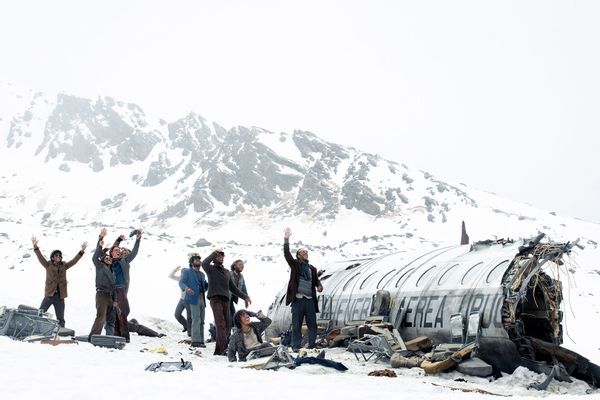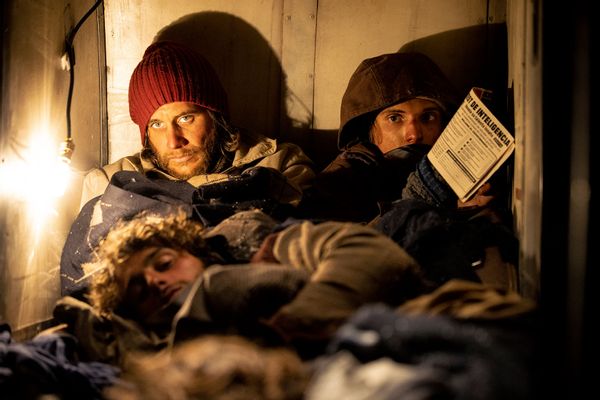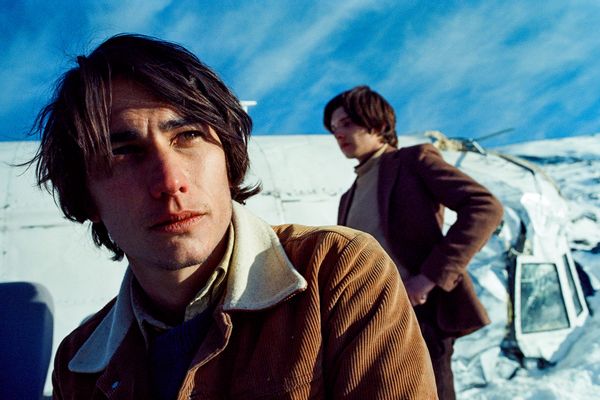
A Spanish-speaking friend of mine recently proposed that we watch “Society of the Snow” together, partly because she knew I’d been practicing my second-language skills. Neither of us had seen the film yet, and ultimately, only one of us would: she decided to renege on her promise after reconsidering the movie’s subject matter. And that is because, despite being a tale of perseverance and triumph, the most enduring legacy of the 1972 Andes plane crash is also its most grim.
J.A. Bayona’s take on the tragedy wallops its viewers with 2 hours and 24 minutes of unrelenting intensity. After a plane carrying a team of Uruguayan rugby players and some of their supporters plunges into the frigid and bleakly uninhabitable South American mountain range, the survivors must resort to unthinkable extremes to muddle through.
Cannibalism in film and television is never a shiny subject, no matter how much social media’s prurience attempted to smooth out Jeffrey Dahmer’s indisputably demented proclivities. But Dahmer was a criminal, a person who, for all accounts, relished the killing and consumption of innocent people. And as Carlitos Páez, one of the 16 survivors of the fateful flight from Montevideo, Uruguay to Santiago, Chile told The Washington Post four years after the crash, “We didn’t do that.”
Speaking about rumors in the immediate aftermath of the survivors’ rescue that they had killed some of the others for food, Páez said, “This bothered us, really, because it wasn't true and it put some doubts in the minds of the families of the other boys that died.”
Thankfully, in Netflix's “Society of the Snow” cannibalism is both desensationalized and overwhelmingly humanized. It’s also woven through with spirituality.
At the start of the film, we see several of the players at a Catholic mass in the seaside capital city of Montevideo. Gastón Costemalle (Jaime Martín James, aka Argentine musician Louta) passes a note through the pews to Numa Turcatti (Enzo Vorgrincic), a law student who is not on the team, which is aptly named Old Christians Club. Gastón is trying to convince Numa to join them on the trip to Chile for a match, which the team has chartered a plane for. But then we hear the sermon.
“No sólo de pan vive el hombre,” says an elderly priest reading to the congregation, quoting a verse from the New Testament. “Man shall not live by bread alone.” Already, even before the fateful trip, the film foreshadows how the concept of eating will be tied to religion and community.
The notion of corporeal consumption — of both a literal and figurative kind — factors heavily into Catholicism. Growing up in a religious, partly Hispanic household, I learned from an early age that eating the Eucharist at church was representative of consuming Jesus’ body and blood. In the real-life Andes story, this belief is what ultimately convinces the most morally averse in the group to eat the dead.
Eventually, they had to tell the world how they were able to survive. At a press conference in Montevideo shortly after their rescue, the men described how they likened eating their friends to the Last Supper, a Catholic belief that Jesus offered himself in the form of bread and wine to his apostles the night before being crucified.

“There’s food outside,” Nando says bluntly, which immediately evinces a simpatico reaction from Roberto Cannessa (Matías Recalt), a medical student. “There’s protein outside,” Roberto echoes. “Energy that we need. Know what happens when you stop eating? The body dries out, just like plants. You can’t use your brain.”
The players quibble briefly over the religious implications of cannibalism, wondering whether God will forgive them or fling them into some damned hellscape. “God put us in this situation,” Roberto says. “He’ll understand we need to survive.”
But just as Roberto begins to assuage concerns about the group’s eternal salvation, the rule of man interjects. One member of the group ponders the legality of consuming another person and asks if they’ll go to prison, a thought which, whether you know the outcome of their plight or not, feels icily ironic: at this point, it seems like none of these guys will make it out of the Andes alive to find out.
After someone conflates cannibalism with organ donation, seemingly to soften the mental blow to the group, Numa delineates doing so as criminal. “We can’t just take, defile and desecrate someone’s body without consent,” Numa says. This scene introduces us to Numa’s principled conscience and ethics, which guides the audience’s experience since it’s his voice that narrates the movie.
The Strauch cousins – Fito, Eduardo, and Daniel (Esteban Kukuriczka, Rafael Federman, Francisco Romero) – volunteer to be the butchers, doing the dirty work in secret away from the rest of the group. “Society of the Snow” is judicious in what we see of the actual cutting and cleaving: a brief shot of pale pink meat, which sort of resembles pieces of frozen sashimi, atop a plate of warped steel; a frame of plucked rib cages, hip bones and spines littering the foreground of the fuselage before the rescue. “What should we do with all this?” Fito asks Eduardo.

One by one, the group begins to sample human flesh, once they accept that their survival necessitates it. The cinematography during a number of these scenes plays up a sense of disorientation, darkness and confusion — distorted and blurry, fish-eye close-ups of the men’s tear-slicked faces remind us that by doing what they must to survive, they are also losing their sense of self. Clearly, this decision was not made lightly.
“Society of the Snow” resists positing the consumption of the survivors’ dead friends as a gruesome act. While it doesn’t shy away from acknowledging the group’s revulsion and horror, the film’s depiction of cannibalism transcends the confines of its conventionally abhorrent definition by comparing it to a form of communion with one’s fellow man.
As the movie progresses, the definition of God evolves into something sweeping and panoptic. Stark shots of the jagged mountains evoke a new sense of divine authority, in nature — looming portentously during the uber-visceral crash scene; lining the horizon of a bruised and starry sky next to thin clouds; wind howling through them at night before a quiet, orange dawn. “This is a place where life is impossible,” Numa narrates. They are no longer governed by the rule of God, but rather, must contend with the law of the mountains.
Bayona neatly squares this concept of the divine in nature later in the film. Arturo Nogueira (Fernando Contigiani García), whose legs were broken in several places during the crash, is strung up toward the rear of the fuselage in a makeshift hammock. He seems fairly clear-headed about his tenuous grasp on life, but Numa nonetheless encourages him to keep the faith.
“I have more faith than I’ve ever had in my whole life,” Arturo counters. “'Cause my faith — sorry, Numa — isn’t in your God. . . . I believe in another God. I believe in the God that Roberto keeps inside his head when he comes to heal each of my wounds. In the God that Nando keeps in his legs that lets him continue walking no matter what. I believe in Daniel’s hands when he cuts the meat, and Fito, when he gives it to us without saying which of our friends it belongs to.”
Once again, we see how “Society of the Snow” emphasizes a transferring of spirituality into people and things — consumption is equated with a pervasive sense of godliness, whatever form God takes. It becomes a form of sacrifice and “generosity” on behalf of those who died, as Bayona told NPR. Eating is a way for the living to honor the memory of the dead, a reciprocal act forged by a pact amongst them: they each preemptively concede their remains to their friends in the event of their death, so that they may carry on. Each fellow man is part of this spiritual existence — be it ordained by God or the mountains — through this agreement, bound by blood.
Right before the film’s turning point, when Roberto and Nando venture out for help, viewers are taken for yet another emotional ride when Numa, our trusty and gritty guide, eventually succumbs to the infected wound in his leg. Before dying, Numa confides in Nando that, despite knowing that the end is near, he is “so happy to know that you guys are gonna make it.” In this moment, we see that Numa is both terrified by his impending mortality and peacefully accepting of it. He knows his death will be what ensures the existence of his companions.

Numa dies clutching a piece of paper that paraphrases John 15:13 in the Bible: “No hay amor más grande que el que de la vida por sus amigos.”
“There is no greater love than to give one’s life for friends.”
We see the remaining survivors once again crowded in the fuselage reading Numa’s note, just as they were when they were debating cannibalism. But this time feels decidedly less dire. Instead, there’s a renewed vigor for survival, for salvation. Driven by the same dogged survival instincts that saw them broach the idea of eating corpses, Nando and Roberto embark on a 10-day hike into Chile in search of help, leading to the group’s subsequent rescue.
Despite being physically gone, Numa continues to narrate the course of the film, a deliberate storytelling choice by Bayona that inculcates the theme of consumption as a type of communion. When the survivors return home, Numa’s voice overlays the throngs of journalists jostling to get near them, the doctors prodding their sun-baked bodies, and the embraces from their incredulous loved ones.
“But they don’t feel like heroes,” Numa tells us.
“Because they were dead like us, and only they got to come back home. Now when they remember us, they ask themselves, ‘Why didn’t we all get to come back? What does it all mean?’ You’ll need to find out yourselves. ‘Cause the answer is in you.” In his final moments of narration, Numa equates the dead with the living once more, reminding us of this fusion's permanence.
By the end of “Society of the Snow,” things feel placid, serene, warm. The dominance of the spirit of those who survived is overwhelming, as is the sacrifice of those who enabled them to.







